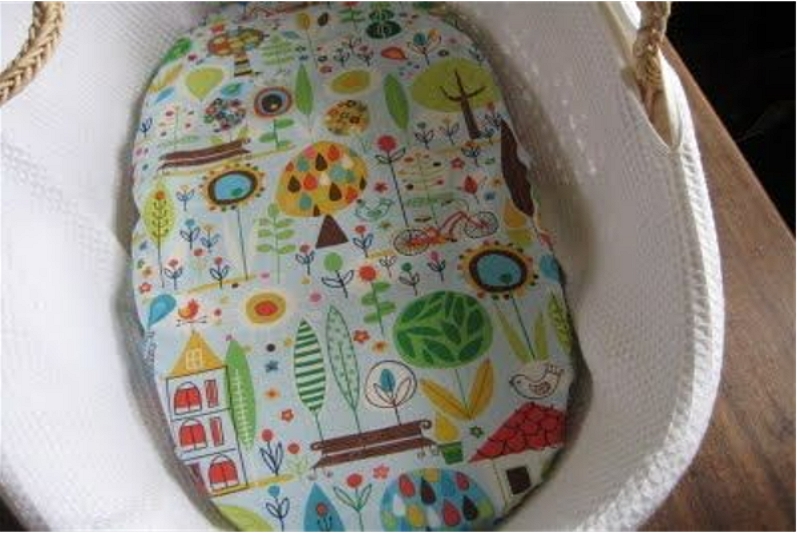If you are looking for how to make a fitted bassinet sheet, this is the article for you. Fitted sheets are great because they will stay in place while your baby sleeps and protect them from kicking off their blankets during sleep. This way, your baby can sleep soundly without having to worry about how cold or hot it is at night!

Steps on How to Make a Fitted Bassinet Sheet
Step 1. First, you need to measure how wide and how long your bassinet mattress is. Make sure that all of the measurements are accurate before starting on anything else! You can also use a pen or pencil for this step if you would like.
Step 2. Then, cut out two pieces of fabric that have those dimensions with some extra room added to them (about half an inch). It might be helpful to fold the piece in half first so that it is easier to work with when laying down other materials onto it later.
Step 3. Now place one sheet face up into the sewing machine along with any batting material and zip ties or elastic cord together at once by arranging everything how they will appear after being sewn together until they’re taut.
Step 4. Sew the three layers together, making sure that you leave enough space for turning and sewing closed once everything is right side out. Make a knot in one end of your cord or zip tie with scissors to hold it securely in place before starting on the next step! Next, use an iron to press the seam allowances open.
Step 5. Turn the sheet right side out and use an iron again to press flat along the seams before sewing them closed with a machine or by hand in a whip stitch, making sure that you also go around any areas where the cord is used to secure corners.
Step 6. Repeat these steps for the other three sides, and then you can insert your pillow form to finish off the bassinet sheet! Make sure that it fits snugly before removing the cord or zip tie so that the baby doesn’t get caught on anything while sleeping in their new bedding.
How to Protect Baby From sun in Bassinet
When you are using a bassinet as a sleeping place for your baby, you must protect them from the sun. Doing so will keep your little ones safe and sound while they sleep during their first few weeks in life.
The best way to do this is by adding a layer of fabric around the bassinet sheet so that no direct sunlight can get through however small gaps might be present between sheets or pillowcase and frame itself.
This will not only help with keeping out harmful UV rays but also reduce heat gain inside bedding which can become dangerous if left unchecked over time. Before going ahead with the plan, however, make sure that any toys hanging off edge don’t pose risks such as suffocation hazards.
How Much Fabric Do I Need for a Bassinet Sheet?
When buying fabric, make sure that you get enough to cover part of the bassinet sheet as well. While a standard sized fitted bassinet sheet should measure about 16 x 30 inches (40 x 75 cm), the amount will vary depending on how stretchable material is and how much your stitching allows it to stretch without tearing apart. For an average sheet, you will need 44 x 75 inches (112 x 193 cm) of fabric.
How to sew a Bassinet Fitted Sheet With Elastic?
Step 1. To make a simple task like this, it’s best to mark out measurements on the side of each piece before cutting them so that pieces end up the same size. When the fabric is already folded over and sewn together, simply cut where you’ve drawn lines to get shapes that are the same length as well as the width of the bassinet mattress.
Step 2. After cutting out all your individual sheet pieces from fabric, it’s time to stitch them together with right sides facing each other before turning everything inside-out so that the wrong side is now on top.
Step 3. You can use hand or machine stitching for this part but I would recommend using an actual sewing machine if you have one because some fabrics might not be easy enough to sew by hand without ripping through it in the process which leaves unsightly holes behind instead of clean edges like a proper seam should produce.
Also, you can stitch pieces together in a way that creates a fitted sheet style without any elastic needed if desired.
Step 4. I would recommend stitching the front and back pieces together first before sides because they are easier to fold inside-out when working with smaller individual pieces like side seams which is a little bit trickier than larger ones around top corners where there isn’t so much excess fabric for turning room.
You’ll want to leave about one inch of extra seam allowance on each end after turning everything right-side-out, then sew another line of stitches through these openings for added security against your baby pulling them open later! Be sure not to make stitches too close or else overlapping areas will be weaker could break more easily under stress.
